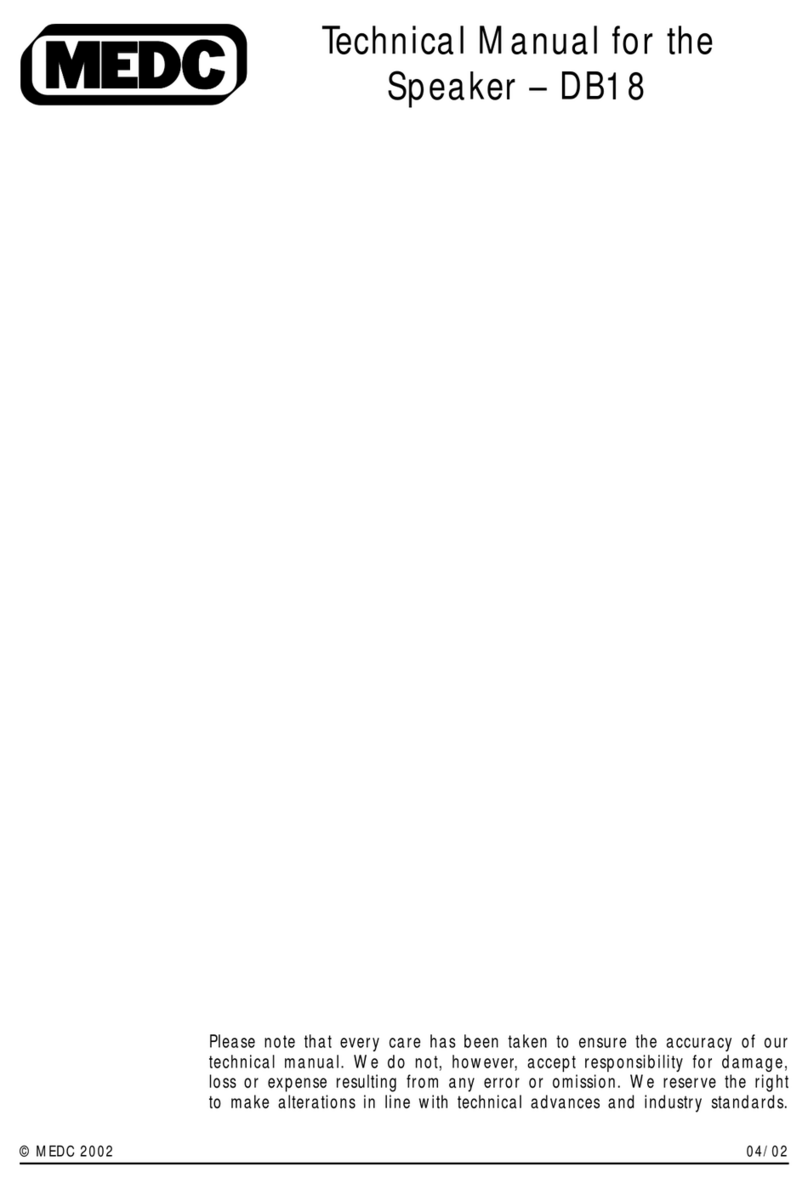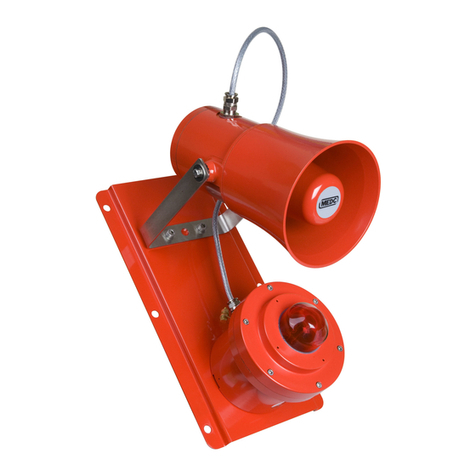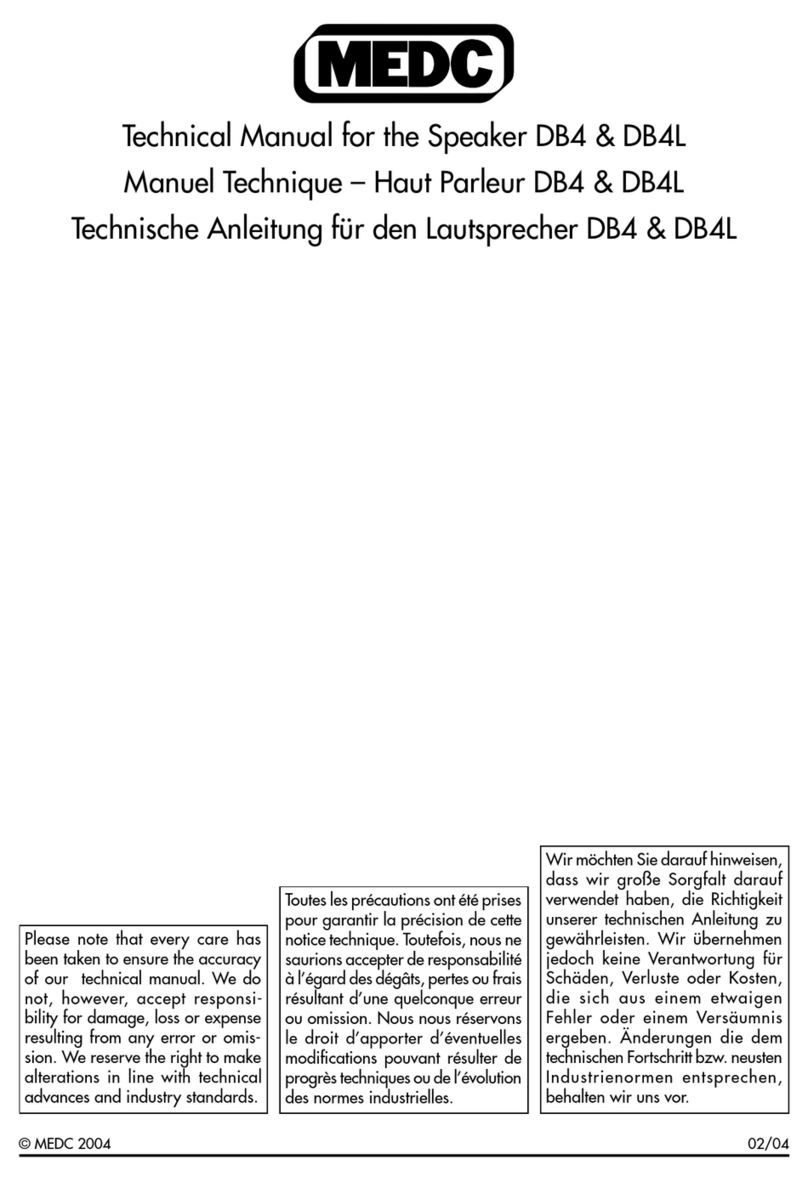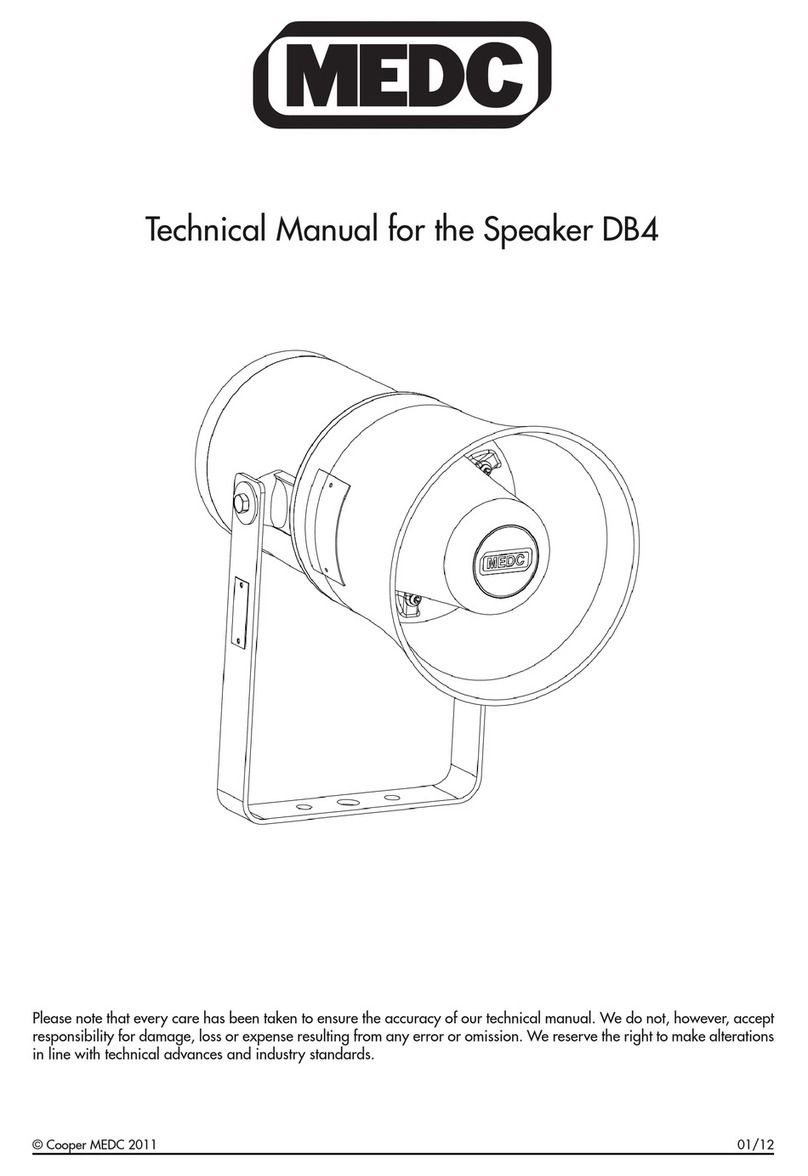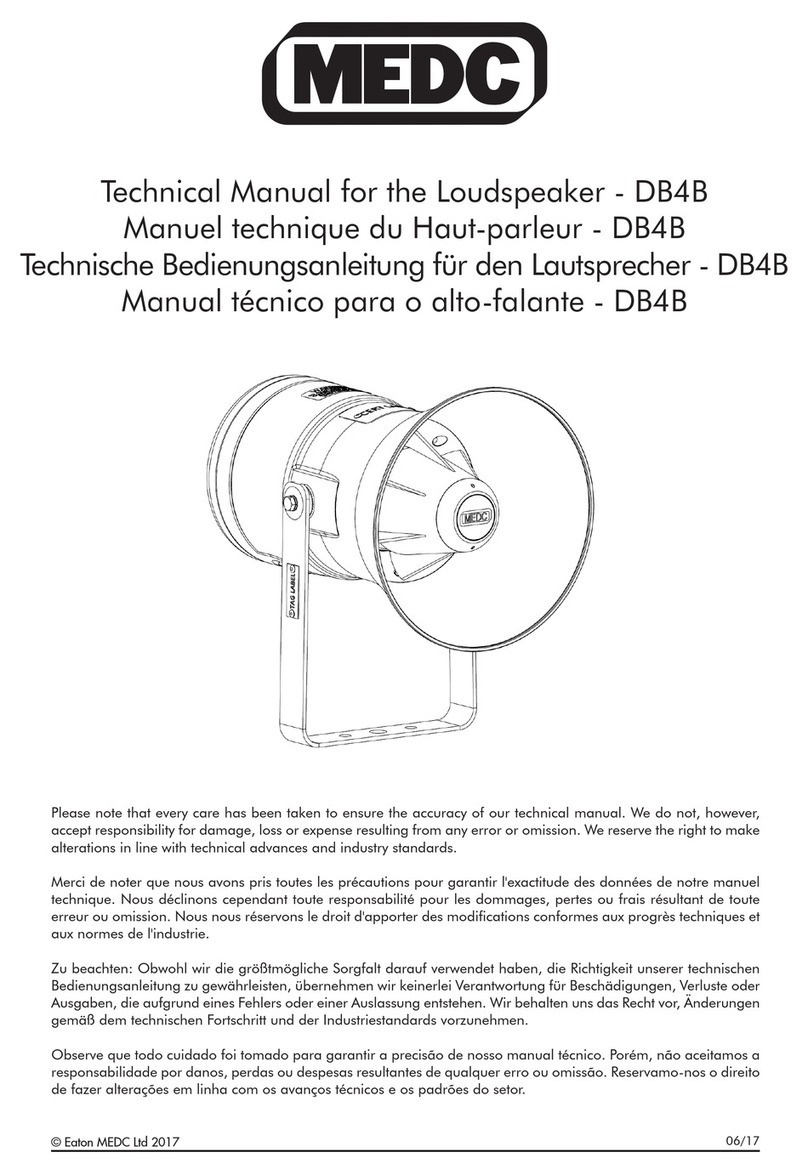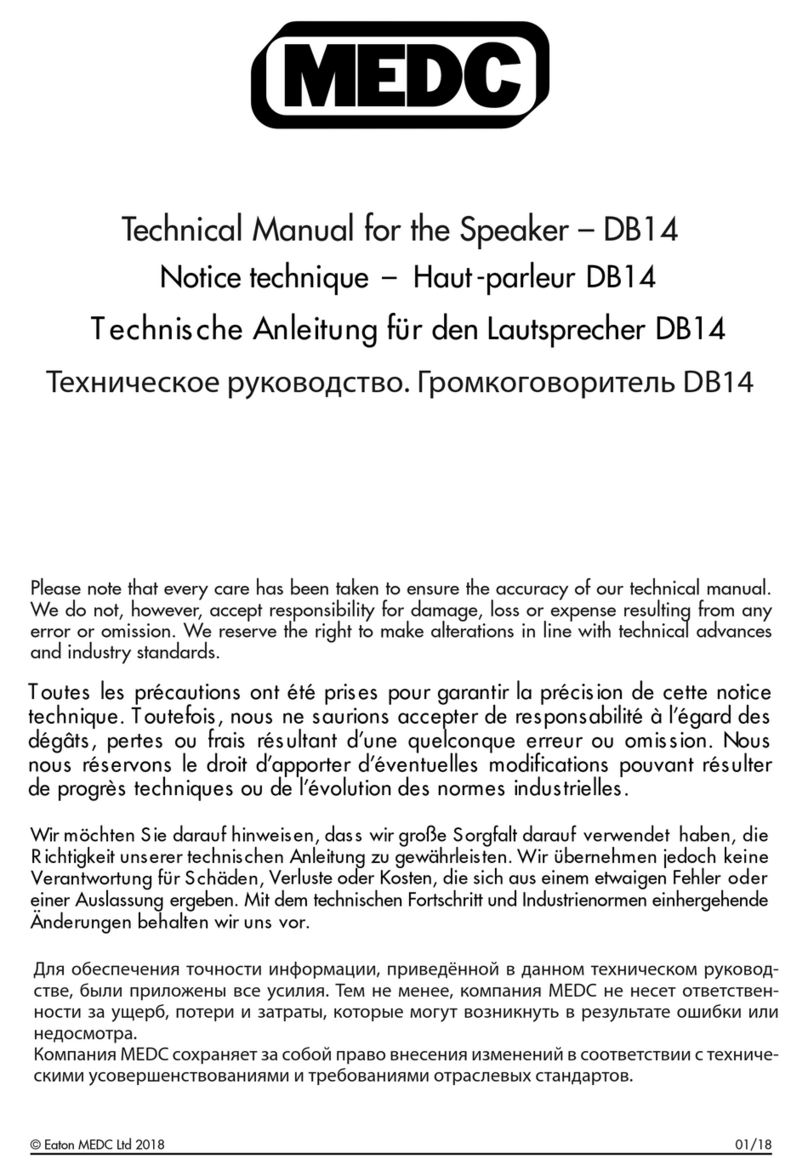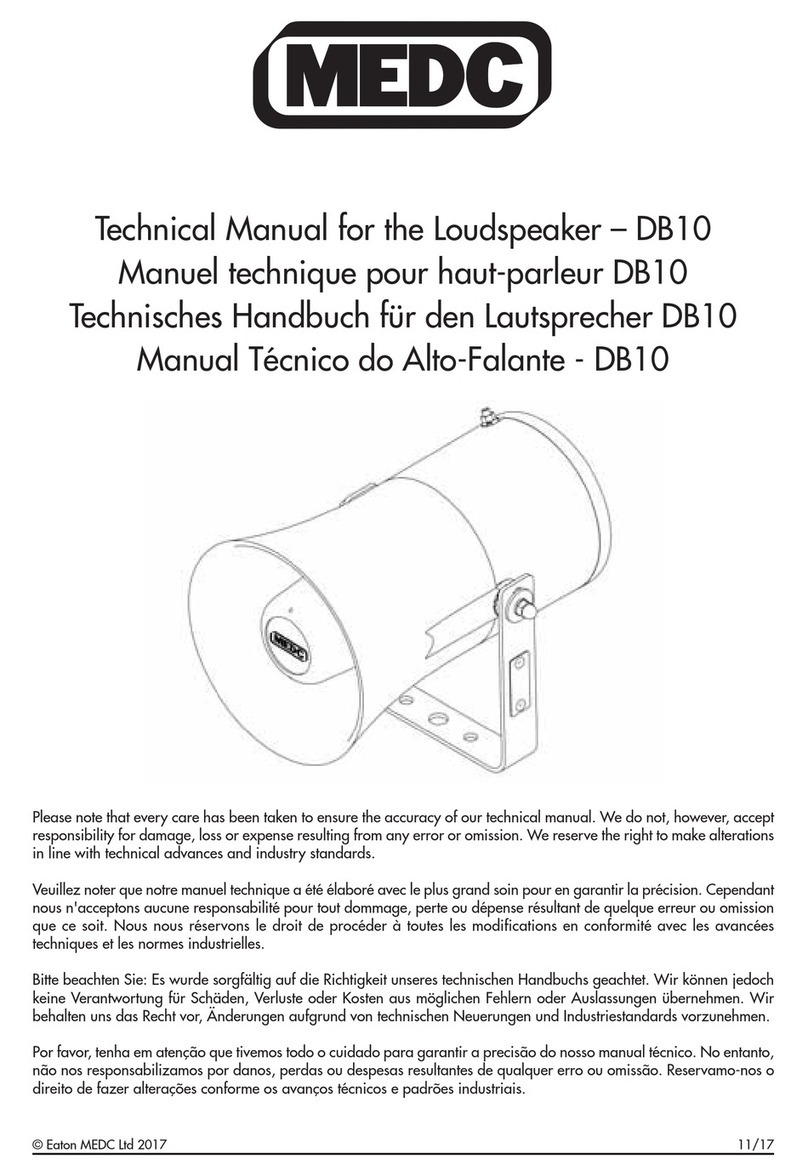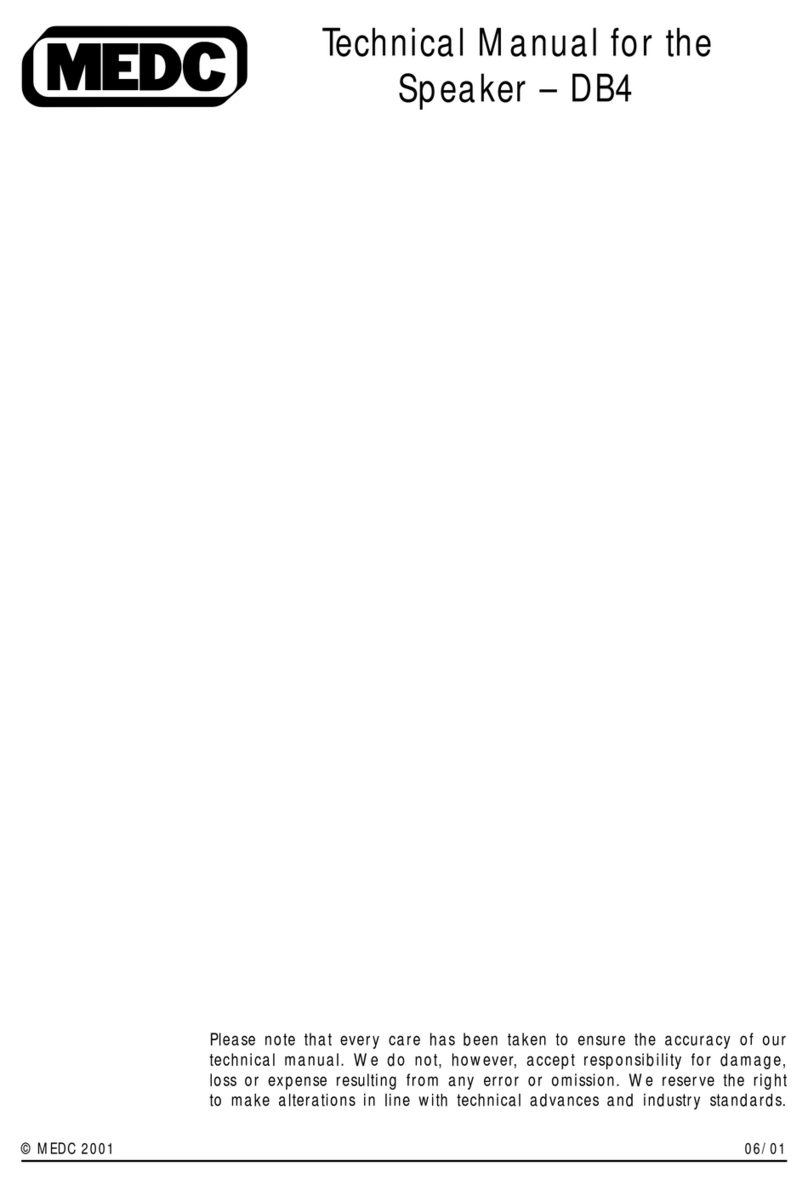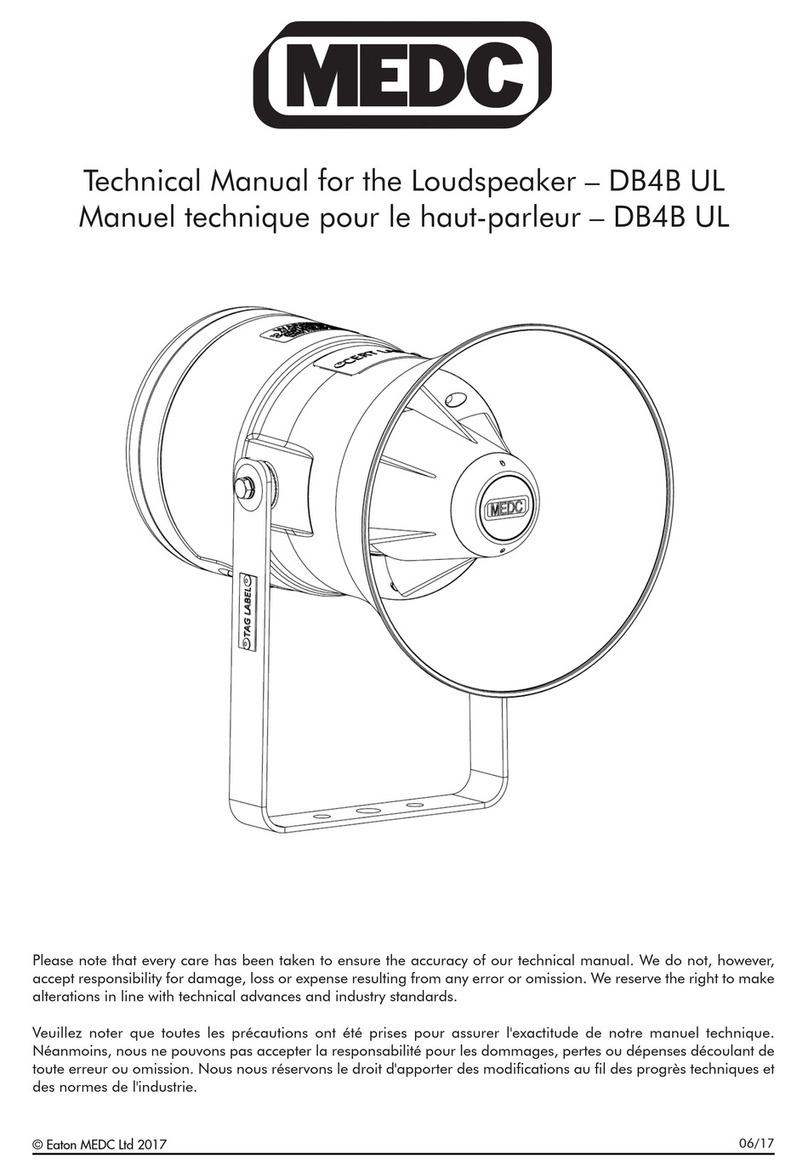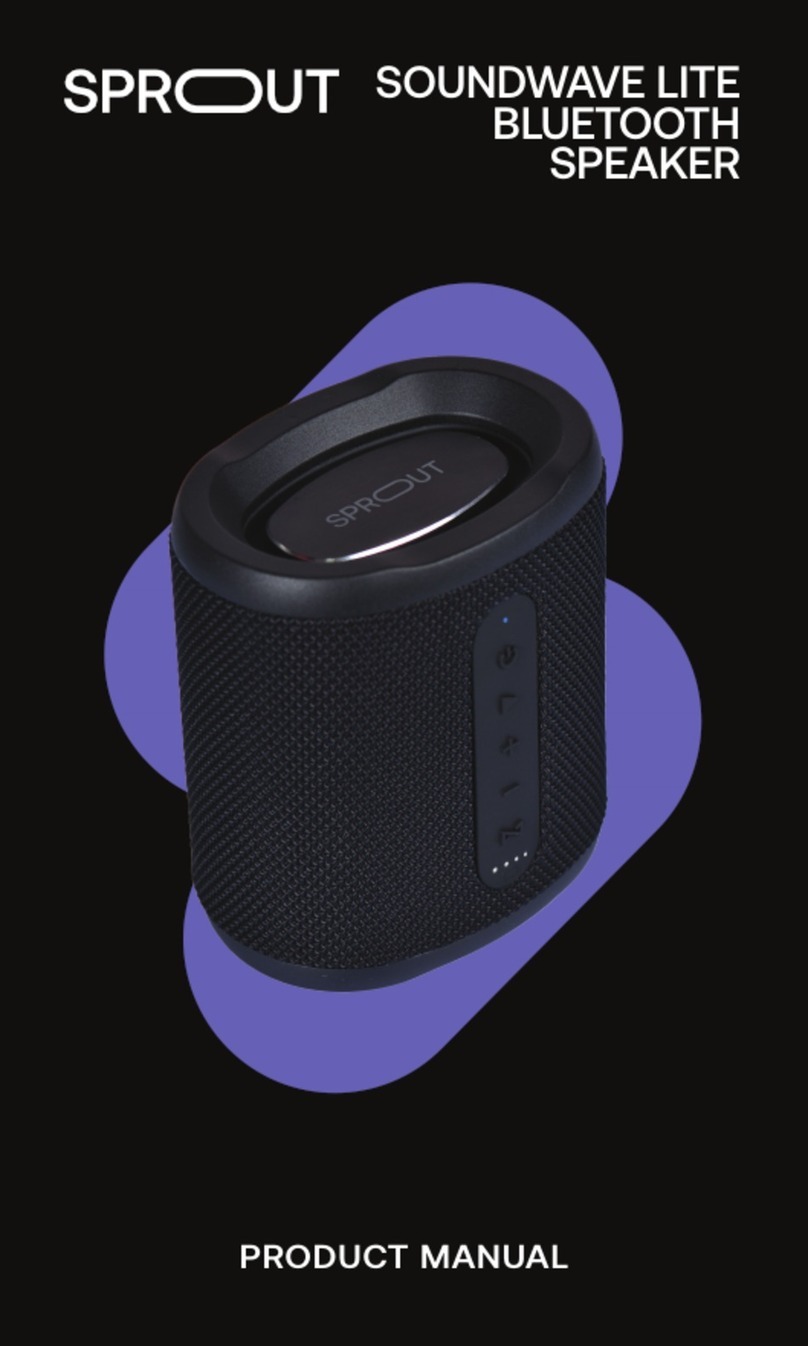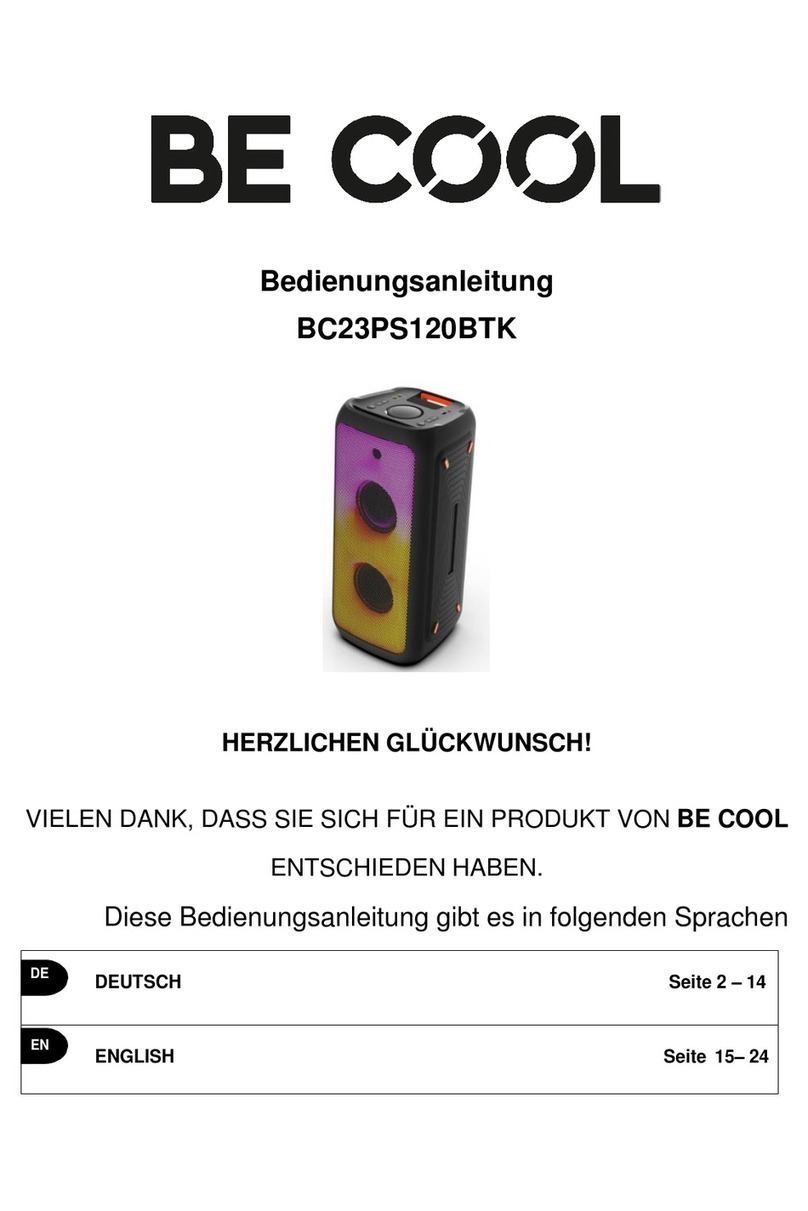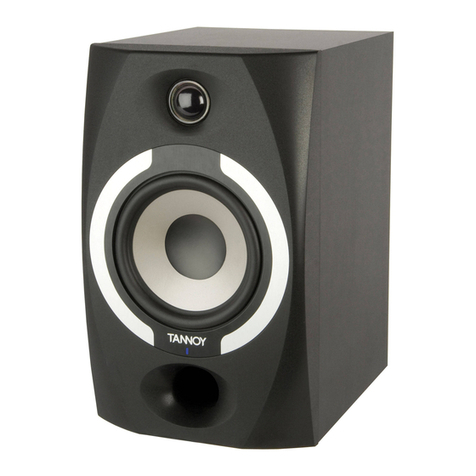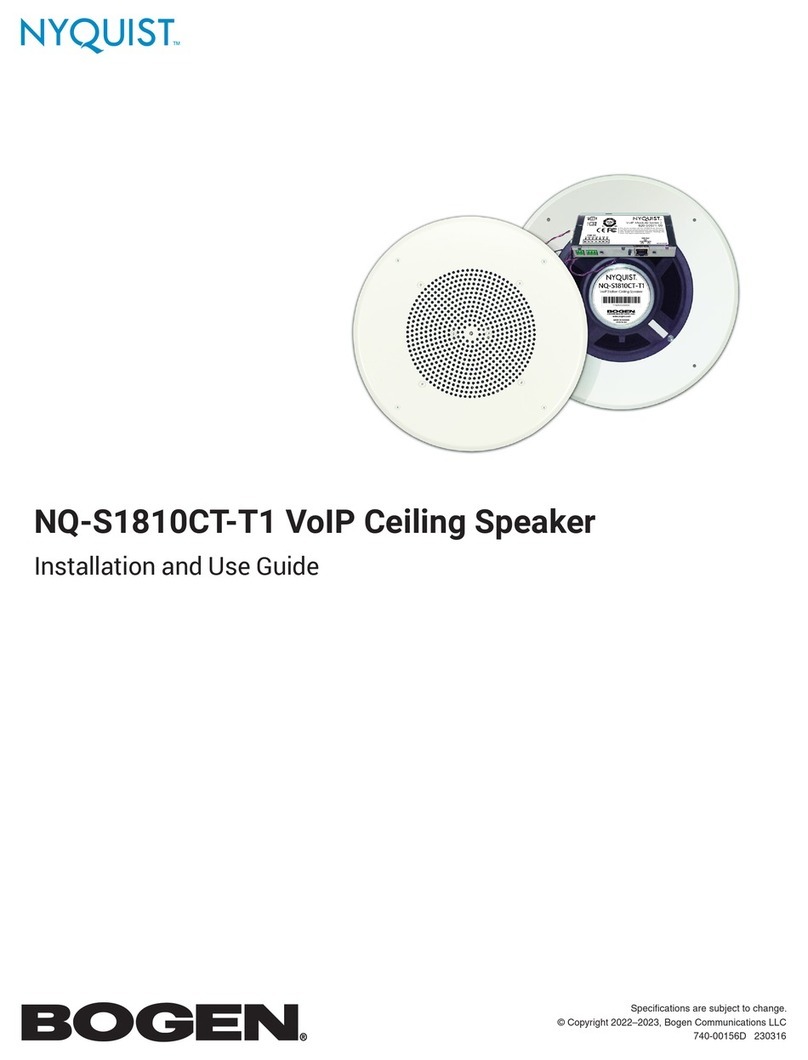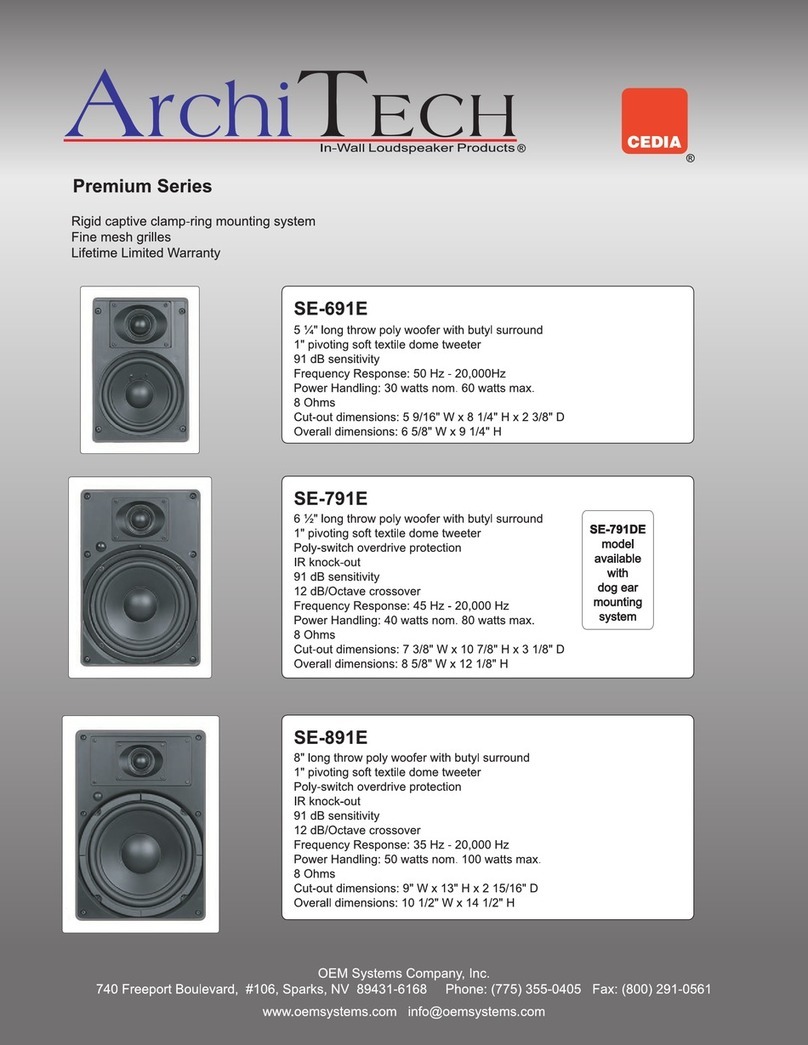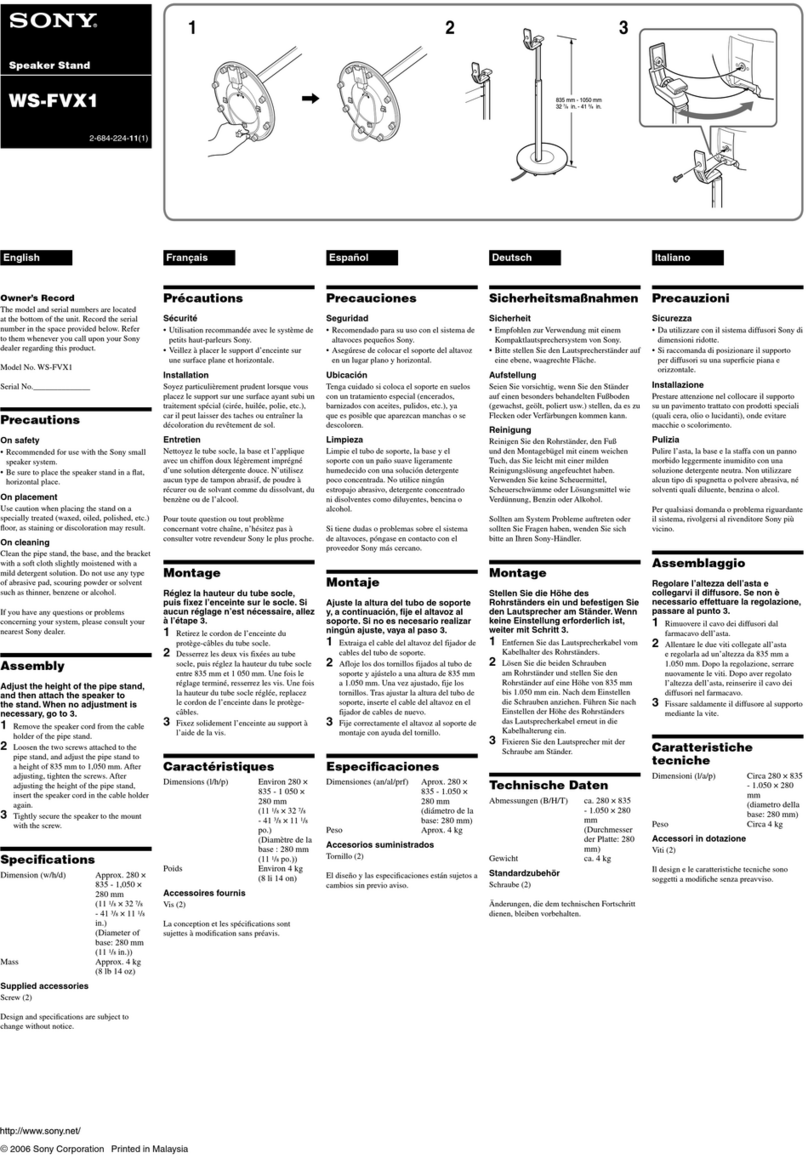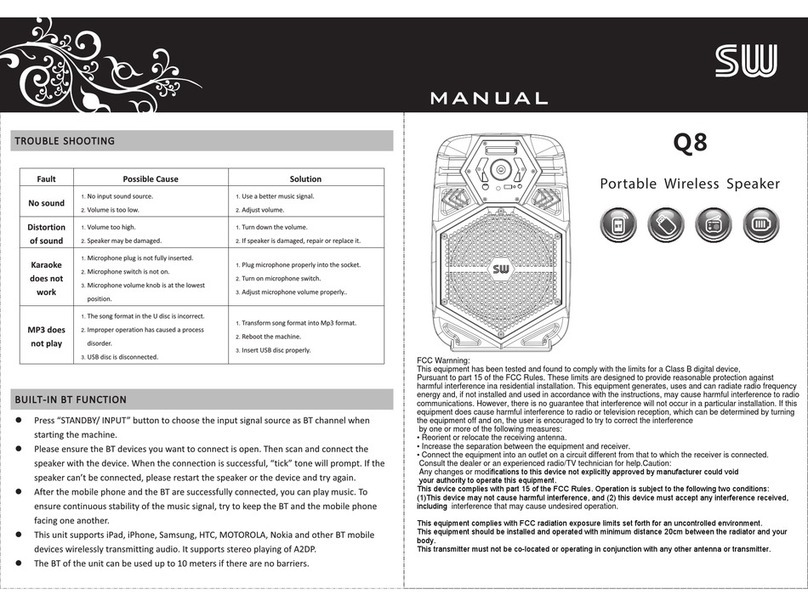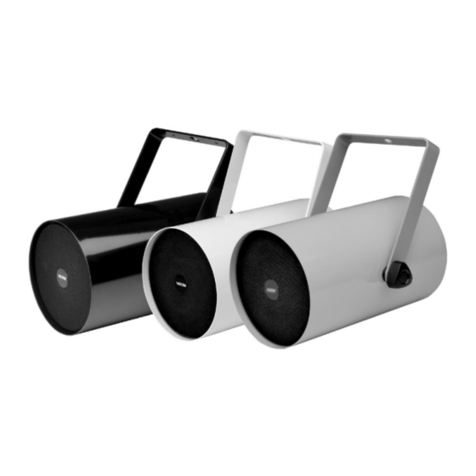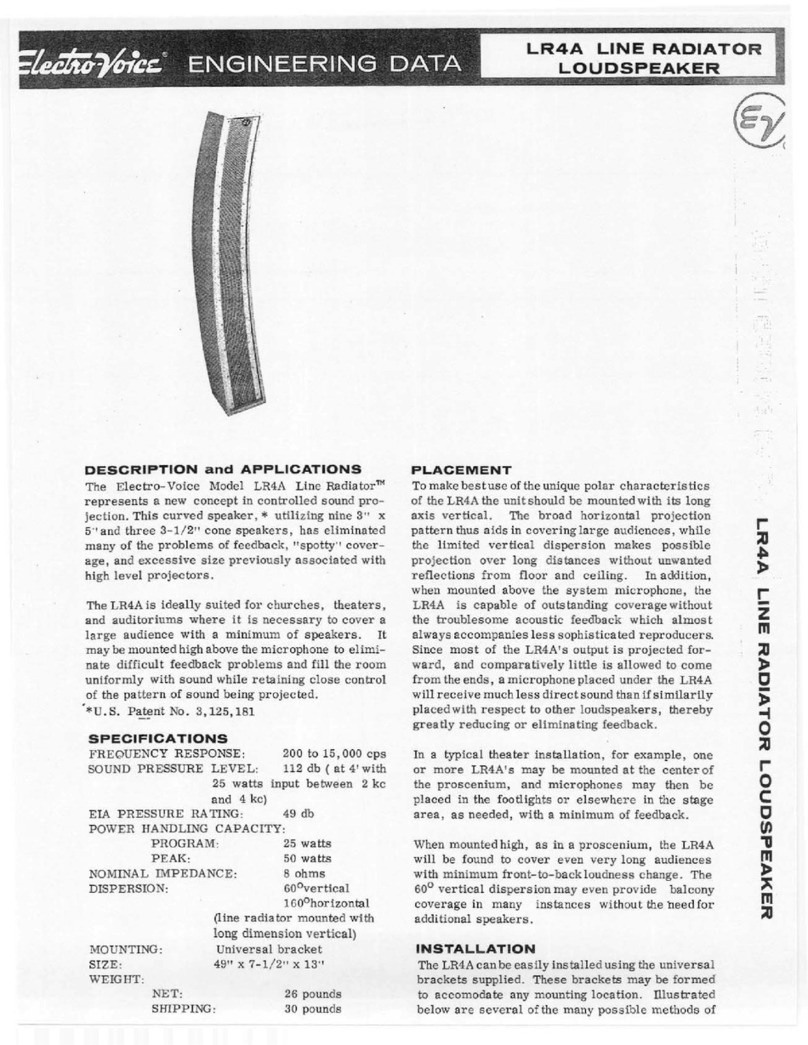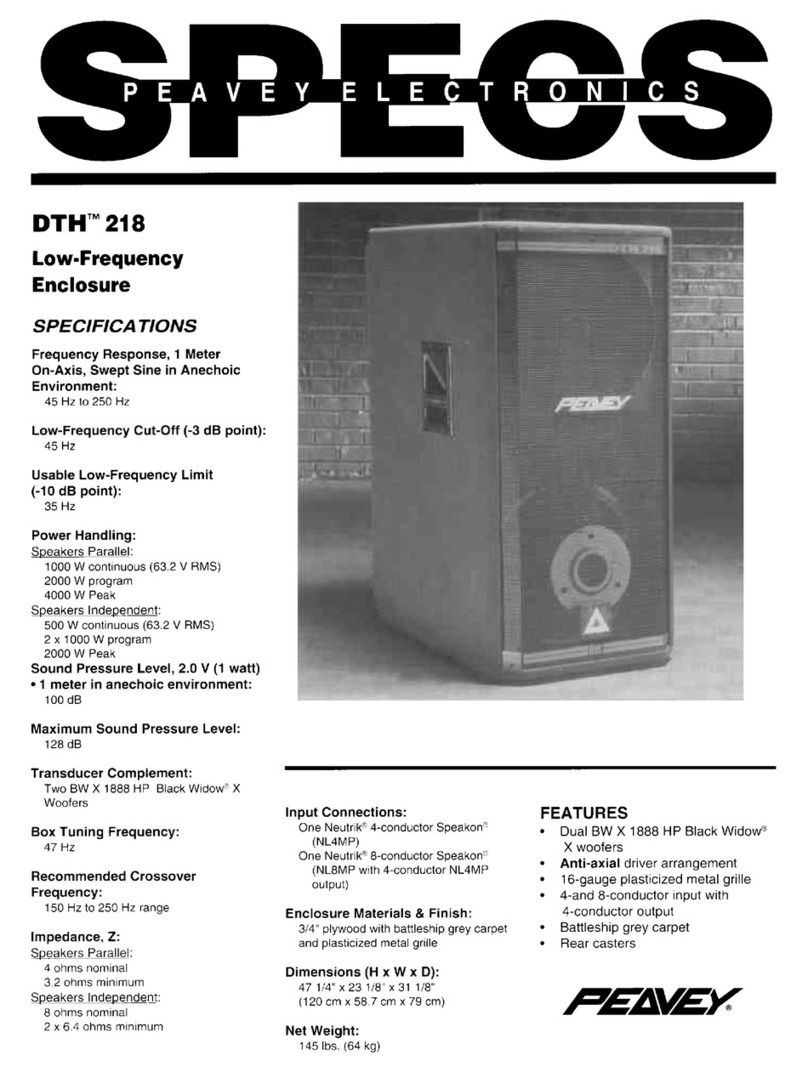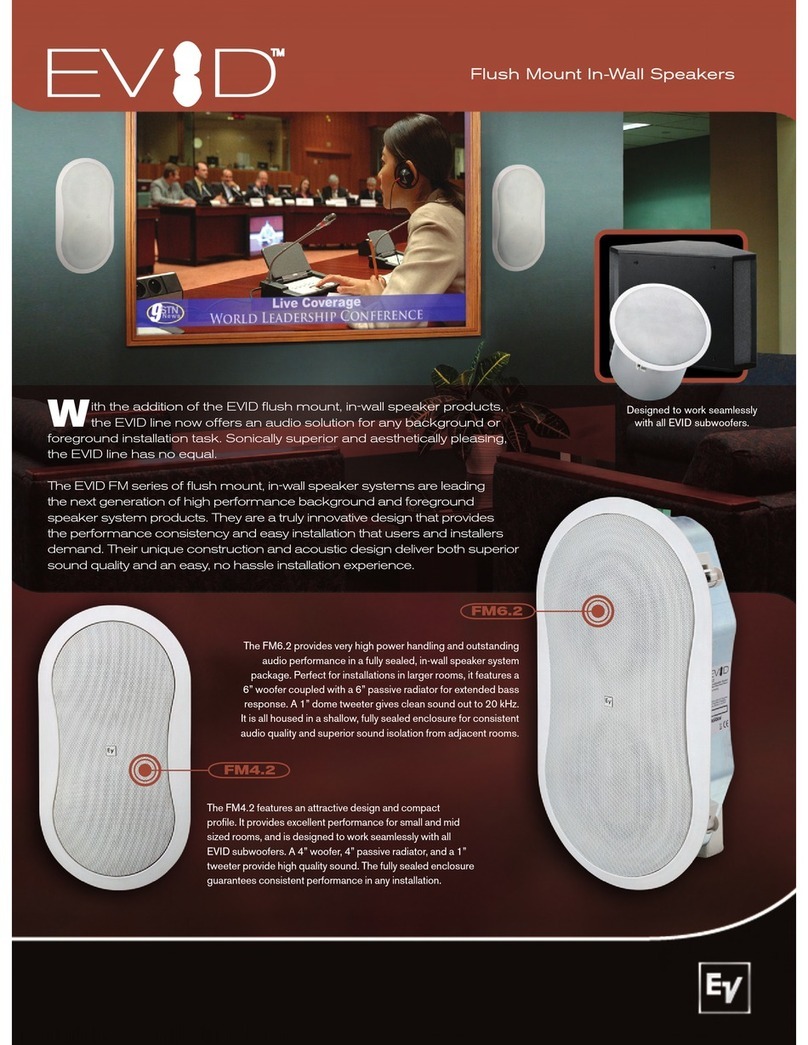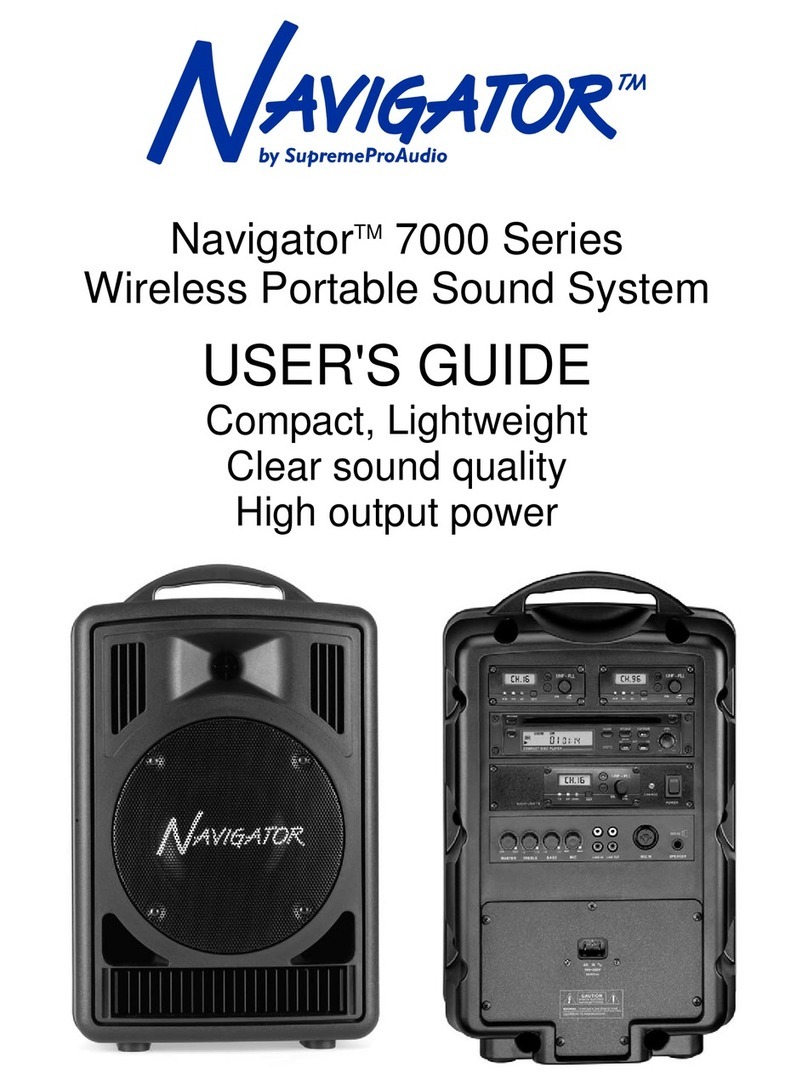MEDC DB3B UL User manual

Eaton MEDC Ltd 2017 06/17
Technical manual for the horn – DB3B UL
Manuel technique de la sondeur – DB3B UL
Please note that every care has been taken to ensure the accuracy of our technical manual. We do not, however,
accept responsibility for damage, loss or expense resulting from any error or omission. We reserve the right to make
alterations in line with technical advances and industry standards.
Veuillez noter que toutes les précautions ont été prises pour assurer l'exactitude de notre manuel technique.
Néanmoins, nous ne pouvons pas accepter la responsabilité pour les dommages, pertes ou dépenses découlant de
toute erreur ou omission. Nous nous réservons le droit d'apporter des modifications au fil des progrès techniques et
des normes de l'industrie.

06/17 Eaton MEDC Ltd 2017

xii. When installing the device, MEDC recommends the use of stainless steel fasteners. Ensure that all nuts,
bolts and fixings are secure.
xiii. The unit should be positioned such that debris, dust or water cannot settle in the re-entrant horn.
xiv. The unit should be positioned such that any solid object, not part of the equipment, is a minimum of 40mm
from the Ex d flamepath joint.
Eaton MEDC Ltd 2017 06/17
viii. This is an Ex d product, correctly listed or certified explosion proof cable glands and stopping plugs must
be used.
xi. The internal earth terminal must be used for protective earthing when required. Do not remove the
internal ground strap from the earth terminal where fitted.
For units with metric entries; gland continuity and earthing my be achieved with an optional external earth
plate. If the external plate is fitted, a thread sealing compound such as H LOMAR PL32 must be employed
to maintain the IP rating of the unit.
1.0 INTRODUCTION
This range of horns, suitable for fire alarm or general use, is intended for use in potentially explosive gas (G) or gas
and dust (GD) atmospheres
Note: (G) unit has nominally 6dB higher output than (GD) unit
The enclosure is manufactured from a UV stable glass reinforced polyester with a rugged thermoplastic flare.
Stainless steel mounting bracket, cover screws and fixings are incorporated throughout thus ensuring a corrosion
free product.
A UL ordinary locations listed version is also available for use in non-explosive atmospheres.
2.0 GENERAL SAFETY MESSAGES AND WARNINGS
All instructions and safety messages in this manual must be followed to allow safe installation of the device. The
device must only be installed and maintained by correctly trained site personnel/installers.
i. To reduce the risk of ignition of hazardous atmospheres and shock, do not apply power to the device until
installation has been completed and the device is fully sealed and secured.
ii. To reduce the risk of ignition of hazardous atmospheres and shock, keep device tightly closed when the
circuit is energised.
iii. Before removing the cover for installation or maintenance, ensure that the power to the device is isolated.
iv. Following installation, test the device to ensure correct operation.
v. Following installation ensure a copy of this manual is made available to all operating personnel.
vi. When installing the device, requirements for selection, installation and operation should be referred to e.g.
IEE Wiring Regulations and the ‘National Electrical Code’ in North America. Additional national and/or
local requirements may also apply.
vii. Cable termination should be in accordance with the specification applying to the required application.
MEDC recommends that all cables and cores should be correctly identified. Please refer to the wiring
diagram in this manual (or separate diagram provided with the unit).
ix. Ensure that only the correct listed or certified stopping plugs are used to blank off unused gland entry
points and that the NEMA/IP rating of the unit is maintained.
x. MEDC recommend the use of a sealing compound such as HYLOMAR PL32 on the threads of all glands
and stopping plugs and/or a suitable sealing washer in order to maintain the IP rating of the unit.
3.0 INSTALLATION
The unit is mounted via 2 off Ø23/64” (Ø9mm) fixing holes in the U-shaped stirrup/mounting bracket. If required,
the unit can be initially placed via the Ø33/64” (Ø13mm) central hole in the stirrup. The unit can then be rotated to
the required position and fixed via the other holes.
If ordered with the unit, a swivel mounting bracket option is available to allow further rotational adjustment to the
unit.
The fixing holes have been designed to accept an Ø5/16” (M8) screw or bolt.
Access to Terminals
The cover is secured with 6 off M5 cover screws (4.0mm A/F hexagon key). Once the cover fixings are unscrewed,
the cover can be lifted away from the enclosure to gain access to the interior. The cover fixings are captive and will
remain in the cover.

Once termination is complete, carefully replace the cover assembly back onto the body, avoiding damage to the
mating surfaces. Tighten the cover screws evenly. Ensure the O-ring is seated correctly on the cover during re-
assembly. Ensure the required maximum gap of 0.0015” (0.038mm) is maintained between the cover and the
enclosure body once assembled.
Wiring details
The unit is available in a number of basic configurations:
1. AC input, single stage.
2. AC input, dual stage with voltage-free stage selection.
3. DC input, up to 3 user selectable stages without monitoring.
4.DC input, up to 2 user selectable stages with EOL / monitoring (standard configuration).
5. DC input, up to 3 user selectable stages with 2 independantly powered stages
6. DC input, up to 3 user selectable stages with optional EOL / monitoring (alternative configuration).
7. DC input, 5 user selectable stages with voltage free stage selection with or without monitoring.
AC version wiring details (Types 1 & 2)
•Type 1: Connect the live and neutral
supply wires to the terminals as detailed in
the wiring diagram. The unit will be
supplied with the link between R1 and R0
fitted to the terminals. When power is
applied to the unit, the stage 1 tone will be
produced as selected on the 5-way DIP
switch.
•Type 2: Connect the live and Neutral
supply wires to the terminals as detailed in
the wiring diagram. The unit will be
supplied with no link fitted between R1
and R0. Connect wires and remote
switches to terminals R0, R1 and R2 as
shown. When power is initially applied to
the unit, no tone will be produced. When
the switch connected to R1 is closed, the
stage 1 tone will be produced as selected
by the 5-way DIP switch on the electronics
assembly. When the switch connected to
R2 is closed, the pre-selected tone for
stage 2 is produced. See tone table 2 for
details of pre-selected tones.
Note: Closing both switches will produce
no tone.
06/17 Eaton MEDC Ltd 2017

DC version –3 stage without monitoring wiring details (Type 3)
This type can be configured in a number of different ways depending on requirements. Independent tone selection
for all 3 stages is via the 3 off 5-way DIP switches fitted to the electronics assembly:
•2-wire system (Single stage): Connect the positive and negative supply wires to the terminals as detailed in
the wiring diagram.
•2-wire system (Dual stage, reverse polarity): Connect the positive and negative supply wires to the
terminals as detailed in the wiring diagram. The second stage is produced by reversing the polarity of the
supply to the unit.
•3-wire system (Dual stage, common +ve): Connect 3 supply wires to the terminals as detailed in the wiring
diagram (1 common +ve wire and 2 -ve wires). Stage 1 is produced when power is applied across the
common +ve and stage 1 -ve terminals. Stage 2 is produced when power is applied across the common
+ve and stage 2 -ve terminals.
•3-wire system (Dual stage, common -ve): Connect 3 supply wires to the terminals as detailed in the wiring
diagram (2 +ve wires and 1 common -ve wire). Stage 1 is produced when power is applied across the
stage 1 +ve and common -ve terminals. Stage 2 is produced when power is applied across the stage 2 +ve
and stage common -ve terminals.
•4-wire system (Triple stage, Common -ve): Connect 4 supply wires to the terminals as detailed in the
wiring diagram (3 +ve wires and 1 common -ve wire). Stage 1 is produced when power is applied across
the stage 1 +ve and common -ve terminals. Stage 2 is produced when power is applied across the stage 2
+ve and common -ve terminals. Stage 3 is produced when power is applied across the stage 3 +ve and
common -ve terminals.
All versions are supplied with terminals to allow loop-in loop-out connection of the supply wires.
Eaton MEDC Ltd 2017 06/17

DC version – Dual stage common +ve with monitoring (standard configuration) wiring details (Type 4)
Connect up to 4 supply wires to the terminals as
detailed in the wiring diagram. Stage 1 is
produced when power is applied across the
common +ve and stage 1 -ve terminals. Stage 2 is
produced when power is applied across the
common +ve and stage 2 -ve terminals.
Monitoring functionality is obtained when the
supply is connected across M1 & M2 terminals.
Note: monitored terminals are not polarity
dependent
DC Version –Up to 3 user selectable stages with 2 independantly powered stages (Type 5)
Connect up to 4 supply wires to the terminals as
detailed in the wiring diagram. Stage 1 is
produced when power is applied across the stage
1 terminals. Stage 2 is produced when power is
applied across the stage 2 terminals. Stages 1 and
2 may be powered from independent supplies.
Stage 3 is produced when power is applied to both
the stage 1 and stage 2 terminals.
Resistors may be added to the terminals as shown
for monitoring purposes. Monitoring functionality is
available at all times if a suitable monitoring relay
is used in the system.
noisrevDC–mmoce
g
a
t
ta
slauD
tseriwylppus4
o
t
o
putcennCo
maragidgniriwehtnidelaitde
iapplsirewponehwdecud
o
pr
ro
1egatsdnaev+nommco -tve
ilihdd
ro
ifnoc
dradnats
(
g
nirotinom
htiw
ev+nom
salsanimretehto
si1eagtS.
ehtss
o
r
acdei
si2egatS.slanimret
htdi
sliated
g
niriw
)
noitaru
g
i
)
4e
p
y
T
(
ty
iapplsirewponehwdecud
o
pr
ro
atsdnaev+nommco 2ge -tve
atbosi
y
t
ilanoitcnufgnir
o
t
o
inMo
1Mss
o
r
ro
cadetcennocsiylppsu
eraslanimretderotinom:etNo
tndenpede
ro
ty
ehtss
o
r
acdei
.slanimret
ehtnehwdenia
s.lanimret2M&
y
t
iralopton
noisreVDC –U lesresu3ot
p
tseriwylppus4
o
t
o
putcennCo
maragidgniriwehtnidelaitde
iapplsirewponehwdecud
o
pr
ro
ecudorpsi2egatS.slanimret1
mret2eagtsehtss
o
r
ro
acdeiappl
pebyam2 pedniomrfdereow
wopnehwedcud
o
r
ro
psi3egaSt
nimrte2egtasdna1egtaseth
eht
o
t
o
deddaebyam
s
r
rs
o
t
o
sisRe
ro
w
po
y
ltndane
p
deni2htiwse
g
atseabltcel
salsanimretehto
si1eagtS.
eagtsehtss
o
r
acdei
sirewopnehwde
dan1seagtS.salnim
.seilppustnednep
htobotedilppasirew
.slan
nwohssaslanimret
p
y
T
(
se
ag
tsderew
)
5e
eht
o
t
o
deddaebyam
s
r
rs
o
t
o
sisRe
inoM.sesoprupgnirotinomrfo
abtiusafisemitlalateabllaiav
.metsysehtnidesuis
ty
nwohssaslanimret
si
y
t
ilanoitcnfugnir
o
t
o
i
byalergnirotinomle
06/17 Eaton MEDC Ltd 2017

DC version –Up to 3 stage with or without monitoring (alternative configuration) wiring details (Type 6)
Note: This alternative configuration must be specified when ordering the unit.
This type can be connected either as a three stage common –ve configuration, or if an optional EOL is specified if
can be configured as a dual stage common –ve system with monitoring.
•4-wire system (Triple stage, Common +ve): Connect 4 supply wires to the terminals as detailed in the
wiring diagram (1 common +ve wire and 3 -ve wires). Stage 1 is produced when power is applied across
the common +ve and stage 1 -ve terminals. Stage 2 is produced when power is applied across the
common +ve and stage 2 -ve terminals. Stage 3 is produced when power is applied across the common
+ve and stage 3 -ve terminals.
•4-wire system (Dual stage, common –ve with monitoring): Connect 4 supply wires to the terminals as
detailed in the wiring diagram. Stage 1 is produced when power is applied across the common -ve and
stage 1 +ve terminals. Stage 2 is produced when power is applied across the common -ve and stage 2 +ve
terminals.
Monitoring functionality is obtained when the supply is connected across M1 & M2 terminals. Note:
monitored terminals are not polarity dependent
DC version with voltage free stage activation wiring details (Type 7)
Eaton MEDC Ltd 2017 06/17
Connect the positive (+ve) and negative (-ve)
supply wires to the terminals as detailed in the
wiring diagram. When power is applied to the
unit, no tone will be produced initially. Connect
wires and remote switches to terminals R0 to R5
as shown. When the switch connected to R1 is
closed, the stage 1 tone will be produced as
selected by the 5-way DIP switch on the
electronics assembly. When any of the other
switches connected to R2 to R5 is closed, the pre-
selected tone for stages 2 to 5 are produced. See
tone table 2 for details of pre-selected tones.
Note: Closing more than one switch at a time will
result in no tone being produced.

4.0 OPERATION
The sounder is available in various AC and DC input voltage versions.
For AC versions, 120Vac and 240Vac units comply with regulated supply limits, for all other AC versions, the
nominal operating voltage is stated on the unit label and the supply voltage tolerance is ±10%.
For 12-48Vdc versions, the absolute input voltage range is 11.0Vdc to 58.0Vdc.
The unit is fitted with a volume control which is positioned on the top face of the electronics assembly PCB.
Maximum volume is obtained when this control is turned fully clockwise. When turned fully anti-clockwise the unit
will emit no sound. For fire alarm use, if the control is not set to maximum volume, ensure the output from the horn
meets the minimum level required by the relevant standards.
Warning: Do not attempt to turn the volume control past its limits of movement as this may cause damage to the
unit.
Directional Characteristics:
Rated SPL directional characteristics as measured in accordance with CAN/ULC-S525-07, clause 7.3.1
Long flare versions:
Nominal output @ nominal power / 3m –112.5dB(A)
Horizontal
Vertical
Point
Angle
SPL dB(A)
Angle
SPL dB(A)
REF.
90°
112.4
90°
112.5
P1
0°
92.2
0°
86.8
P2 (-6dB) !1R
30°
106.7
30°
106.7
P3 (-3dB) !2R
25°
108.9
25°
109.7
P4 (-3dB) !2L
25°
109.2
30°
109.2
P5 (-6dB) !1L
30°
106.0
40°
106.4
P6
180°
87.8
180°
90.0
06/17 Eaton MEDC Ltd 2017

Eaton MEDC Ltd 2017 06/17
Short flare versions:
Nominal output @ nominal power / 3m –99.6dB(A)
Horizontal
Vertical
Point
Angle
SPL dB(A)
Angle
SPL dB(A)
REF.
90°
95.7
90°
99.6
P1
0°
87.1
0°
91.1
P2 (-6dB) !1R
85°
89.8
55°
93.4
P3 (-3dB) !2R
50°
92.9
50°
96.9
P4 (-3dB) !2L
50°
92.9
45°
96.9
P5 (-6dB) !1L
85°
89.8
55°
93.4
P6
180°
93.2
180°
90

06/17 Eaton MEDC Ltd 2017
Stages
For all versions, a 5-way DIP switch selects the stage required for each stage. The settings for the standard stages
are shown in the table below:
Tone table 1:
TONE
No.
TONE FREQ/DESCRIPTION
SWITCH
SETTING
12345
TONE DESCRIPTION
Nominal SPL
(dB(A) @ 1M)
1
Alt Stages 800/970 Hz at 1/4 sec
11111
112
2
Sweeping 800/970 Hz at 7 Hz
11110
Fast Sweep (LF)
111
3
Sweeping 800/970 Hz at 1 Hz
11101
Medium Sweep (LF)
113
4
Continuous at 2850 Hz
11100
111
5
Sweeping 2400-2850 Hz at 7 Hz
11011
Fast Sweep
112
6
Sweeping 2400-2850 Hz at 1 Hz
11010
113
7
Slow Whoop
11001
Slow Whoop
113
8
Sweep 1200-500 Hz at 1 Hz
11000
Din Stage
117
9
Alt Stages 2400/2850 Hz at 2 Hz
10111
111
10
Int Stage of 970 Hz at 1 Hz
10110
Back-up Alarm (LF)
112
11
Alt Stages 800/970 Hz at 7/8 Hz
10101
112
12
Int Stage at 2850 Hz at 1Hz
10100
Back-up Alarm (HF)
112
13
970 Hz at 1/4 sec on 1 sec off
10011
112
14
Continuous at 970 Hz
10010
112
15
554 Hz for 0.1S/440 Hz for 0.4S
10001
French Fire Sound
113
16
Int 660 Hz 150 mS on 150 mS off
10000
Swedish Fire Alarm
108
17
Int 660 Hz 1.8 sec on 1.8 sec off
01111
Swedish Fire Alarm
108
18
Int 660 Hz 6.5 sec on 13 sec off
01110
Swedish Fire Alarm
109
19
Continuous 660 Hz
01101
Swedish Fire Alarm
108
20
Alt 554/440 Hz at 1 Hz
01100
Swedish Fire Alarm
113
21
Int 660 Hz at 7/8 Hz
01011
Swedish Fire Alarm
108
22
Int 2850 Hz 150 mS on 100 mS off
01010
Pelican Crossing
111
23
Sweep 800-970 Hz at 50 Hz
01001
Low Freq. Buzz
109
24
Sweep 2400 -2850 Hz at 50 Hz
01000
High Freq. Buzz
111
25
3x970 Hz pulses 0.5 off, 1.5 off
00111
112
26
3x2850 Hz pulses 0.5on/0.5off, 1.5 off
00110
112
27
Int 3100 Hz 0.32s on/0.68s off
00101
105
28
Continuous 1400 Hz
00100
125
29
Spare / Custom tone
00011
30
Spare / Custom tone
00010
31
Spare / Custom tone
00001
32
Spare / Custom tone
00000
Note: If special tones were requested at the time of ordering, please see the separate tones list supplied with the unit
for details of these special tones and their respective switch settings.

Eaton MEDC Ltd 2017 06/17
Tone table 2: Pre-selected tone details for voltage-free activation stages:
Voltage free stage selection tone No.
TONE
No.
TONE FREQ/DESCRIPTION
SWITCH
SETTING
12345
DC
AC
Stage 1
Stage
2
Stage
3
Stage
4
Stage
5
Stage
2
1
Alt Tones 800/970Hz at 1/4 sec
11111
T14
T10
T11
T8
T14
2
Sweeping 800/970Hz at 7 Hz
11110
T14
T10
T1
T8
T14
3
Sweeping 800/970Hz at 1 Hz
11101
T14
T10
T1
T8
T14
4
Continuous at 2850Hz
11100
T14
T10
T1
T8
T14
5
Sweeping 2400-2850Hz at 7Hz
11011
T14
T10
T1
T8
T14
6
Sweeping 2400-2850Hz at 1Hz
11010
T14
T10
T1
T8
T14
7
Slow Whoop
11001
T14
T10
T1
T8
T14
8
Sweep 1200-500Hz at 1Hz
11000
T14
T10
T1
T6
T14
9
Alt Tones 2400/2850Hz at 2Hz
10111
T14
T10
T1
T8
T14
10
Int Tone of 970Hz at 1Hz
10110
T14
T12
T1
T8
T14
11
Alt Tones 800/970Hz at 7/8Hz
10101
T14
T10
T1
T8
T14
12
Int Tone at 2850Hz at 1Hz
10100
T14
T10
T1
T8
T14
13
970Hz at 1/4 sec on 1 sec off
10011
T14
T10
T1
T8
T14
14
Continuous at 970Hz
10010
T28
T10
T1
T8
T28
15
554Hz for 0.1S/440Hz for 0.4S
10001
T14
T10
T1
T8
T14
16
Int 660Hz 150 mS on 150 mS off
10000
T14
T10
T1
T8
T14
17
Int 660Hz 1.8 sec on 1.8 sec off
01111
T14
T10
T1
T8
T14
18
Int 660Hz 6.5 sec on 13 sec off
01110
T14
T10
T1
T8
T14
19
Continuous 660Hz
01101
T14
T10
T1
T8
T14
20
Alt 554/440Hz at 1Hz
01100
T14
T10
T1
T8
T14
21
Int 660Hz at 7/8Hz
01011
T14
T10
T1
T8
T14
22
Int 2850Hz 150 mS on 100 mS off
01010
T14
T10
T1
T8
T14
23
Sweep 800-970Hz at 50Hz
01001
T14
T10
T1
T8
T14
24
Sweep 2400-2850Hz at 50Hz
01000
T14
T10
T1
T8
T14
25
3x970Hz pulses 0.5 off, 1.5 off
00111
T14
T10
T1
T8
T14
26
3x2850Hz pulses 0.5on/0.5off, 1.5 off
00110
T14
T10
T1
T8
T14
27
Int 3100Hz 0.32s on/0.68s off
00101
T14
T10
T1
T8
T14
28
Continuous 1400Hz
00100
T14
T10
T1
T8
T14
29
Spare / Custom tone
00011
30
Spare / Custom tone
00010
31
Spare / Custom tone
00001
32
Spare / Custom tone
00000

06/17 Eaton MEDC Ltd 2017
GENERAL ARRANGEMENT
5.0 MAINTENANCE
During the working life of the unit, it should require little or no maintenance. GRP will resist attack by most acids,
alkalis and chemicals and is as resistant to concentrated acids and alkalis as most metal products.
However, if abnormal or unusual environmental conditions occur due to plant damage or accident etc., then visual
inspection is recommended.
If the unit requires cleaning, then only clean exterior with a damp cloth to avoid electro-static charge build up.
If a unit fault should occur, then the unit can be repaired by MEDC.
If you acquired a significant quantity of units, then it is recommended that spares are also made available. Please
discuss your requirements with the Technical Sales Engineers at MEDC.

Eaton MEDC Ltd 2017 06/17
6.0 CERTIFICATION/APPROVALS
UL listed for use in USA (USL) and Canada (CNL) –Audible signal applicance for fire alarm or general use.
Please refer to the marking on the unit for specific approval details
(USL)
Class I, Zone 1 AEx d IIC T*
Zone 21 AEx tb IIIC
(CNL)
Class I, Zone 1 Ex d IIC Gb T*
Class II, Div. 1, Groups F & G
Also suitable for:
Class I, Div. 2 Groups A, B, C, D
Class II, Div. 2, Groups F & G
Class III, Div. 1
Class II, Div. 1 groups E, F & G (available for CNL by special request only)
Appliccable Standards:
(USL)
UL 60079-0, Edition 6
UL 60079-1, Edition 6
ANSI/ISA 60079-31, Edition 1
(CNL)
CSA C22.2 No. 60079-0:11
CSA C22.2 No. 60079-1:11
CSA C22.2 No. 60079-31, Edition 2
CAN/ULC-S525-07
T-Ratings:
Max. Power rating
Tamb.
T-ratings (T*)
-67°F to +158°F (-55°C to +70°C)
T4/T135°C
-67°F to +131°F (-55°C to +55°C)
T5/T100°C
15W
-67°F to +104°F (-55°C to +40°C)
T6/T85°C
Electrical ratings:
The DB3B is available in a number of different input voltage variations:
1. 12 V to 48 V dc, 716 mA to 171 mA, Special Application *
2. 110 Vac, 50/60 Hz, 122mA, Special Applicaton.
3. 120 V ac, 50/60 Hz, 110 mA, Regulated.
4. 220/230/ Vac, 50/60 Hz, 63 mA, Special Application.
5. 240 Vac, 50/60 Hz, 58 mA, Regulated
*NOTE: the DC special application version is suitable for use with 24Vdc regulated supplies.

06/17 Eaton MEDC Ltd 2017
7.0 SPECIAL CONDITIONS FOR SAFE USE
1.For replacement purposes the cover fixing screws shall be of stainless steel grade A2-70 or stronger.
2.Painting and surface finishes, other than those applied by the manufacturer, are notpermitted.
3. When the unit is used in dust atmospheres the cable entries used shall be sealed to maintain the IP6X
rating, in accordance with the applicable installation codes.
4. Warning - Do not open when an explosive atmosphere is present
5. For supply connections, use minimum 105°C rated wire
6.Clean enclosure with damp cloth
7. Warning – to reduce the risk of ignition of hazardous atmospheres, conduit openings must have a sealing
fitting connected within 1 inch (25.4mm) of the enclosure

Eaton MEDC Ltd 2017 06/17
8.0 Functional Safety
Introduction
The DB3B Sounder has been designed for use in potentially explosive atmospheres and harsh
environmental conditions. The glass reinforced polyester enclosures are suitable for use offshore
or onshore, where light weight combined with corrosion resistance is required.
The safety function of the Sounder is to provide a pre-determined audible warning sound when
required if the correct voltage is applied to the unit. The DC version of the Sounder is designed to
operate on a supply voltage between 12-48v dc
Under No fault (Normal) Operating conditions the DB3B Sounder will provide an audible
warning sound when required by the system.
Under fault conditions the failure mode of the Sounder is a failure to provide an audible warning
sound. For the failure rate associated with this failure mode please refer to the table below.
Assessment of Functional Safety
This Sounder is intended for use in a safety system conforming to the requirements of IEC61508.
UL has conducted a Failure Modes Effect and Diagnostic Analysis (FMEDA) of the DB3B Sounder
against the requirements of IEC 61508-2 using a Proof Test Interval of 8760hrs.
The results are shown below and are based on Route 1H
The Sounder is classed as a Type B device
DB3B SOUNDER
Safety Function of DB3B Sounder:
To provide a pre-described audible warning sound when required’
Summary of Clauses
2/7.4.2 and 2/7.4.4
DB3B Sounder
Single Mode (1oo1)
DB3B Sounder
Redundant Mode (1oo2) Verdict
HFT=0 HFT=1 Type B
Architectural constraints
Safe Failure Fraction (SFF) 65.9% 65.9% SIL 1(1oo1)
SIL 2 (1oo2)
Random hardware
failures: [h-1 ]
!DD
!DU
6.5E+09
1.16E-07
6.5E+10
1.16E-08
Random hardware
failures: [h-1 ]
!SD
!SU
0.00E+00
2.18E-07
0.00E+00
2.18E-08
PFD @ PTI = 8760Hrs
MTTR = 8 Hrs 5.09E-04 5.09E-05 SIL 3(1oo1)
Average freq. of dangerous failure (high
demand-PFH)[h-1] 1.16E-07 1.16E-08 SIL 2(1oo1)
Hardware safety integrity
compliance Route 1H
Systematic safety integrity
compliance Route 1s
Systematic Capability
(SC1, SC2, SC3, SC4) SC2
Hardware safety integrity achieved Limited to: SIL 1 (1oo1) & SIL 2 (1oo2) due to SFF value.

06/17 Eaton MEDC Ltd 2017
Conditions of Safe use
The following conditions apply to the installation, operation and maintenance of the assessed
equipment. Failure to observe these may compromise the safety integrity of the assessed
equipment:
1. The user shall comply with the requirements given in the manufacturer’s user documentation
(This Safety Manual and Technical manual) in regard to all relevant functional safety aspects
such as application of use, installation, operation, maintenance, proof tests, maximum ratings,
environmental conditions, repair, etc;
2. Selection of this equipment for use in safety functions and the installation, configuration,
overall validation, maintenance and repair shall only be carried out by competent personnel,
observing all the manufacturer’s conditions and recommendations in the user documentation.
3. All information associated with any field failures of this product should be collected under a
dependability management process (e.g., IEC 60300-3-2) and reported to the
manufacturer.
4. The unit should be tested at regular intervals to identify any malfunctions; in accordance with
this safety manual.
5. If the product is used in a redundant installation, both hardware safety integrity and
systematic safety integrity for SIL 2 can be achieved. The installation must be such as to ensure
sufficient protection against common cause failures and independence from cascading
failures.
esu
e
f
fe
aSfonsoitindoC
ontiidoncgniowl
ol
f
fol
ehT
e toeruliaFt.nempiuq
t:nempiuqe
1. pomcllahsresuehT
launaMtyefaSsihT(
ontiacilppasahcus
dnocltanemonrivne
2. qesithofonticeleS
m,ontiadilavllareov
amethllagnivresob
rv
areop,ontialltasniethtoylppasn
esiomrpmocyamesethe
v
r
esob
ninevigtsnemeriuqereththiwylp
dragerni)launamlacinhceTdnal
niam,notiareop,ontialltasni,esuof
;tce,riaper,sontii
oticnuftyefasniesu
or
f
for
tnempiuq
ylonllahsriaperdnaecnanteniam
omcerdnasontiidoncs’rertucafuna
essaethofecnanteniamdnaontia
essaethoftyirgetnityefasethe
tnemuocdresus’rertucafunameth
na
v
e
ev
lerllato satyefaslaonticnuft
tarmumixam,tssteoofrp,ecnanten
arugifonc,ontialltasniethdnason
osreptnteepomcybtoudeirraceb
ttanemuocdresuethnisontiadnem
desse
desse
ontita
tsceps
,sgnti
,onita
,lenon
.onti
ty
g
3. ossanoitamronfillA
nam
y
t
ilibandeped
rerutcafnuam .
4. tebdlouhstinuehT
.launam
ty
e
t
fassith
5. usitcuodrpethfI
tenityefasctiamtesys
onticoterptneiciffus
.serulifa
htfos
e
r
re
uliafdleifnyahtiwd
e
t
te
aico
CEI,.g.e(ssecorpntemegna
ftineditoslavrteniralugertadteste
idesu ,ontialltasnitnadnuderan
hT.de
v
e
ev
ihcaebnac2LIS
or
f
for
tyirge
eruli
a
f
fa
esuaconmomctsniagan
fy
hostcudorpshi ndudetcellocebdlu
00306 -3- otdetropernda)2
ecnadorccani;sonticnuflamyna
y
f
tyirgtenityefaserawdrahothb,
etosahcusebtsumontialltasnieh
acsacomrfecnednepednidnas
ared
het
thiwe
dna
erusn
gnida

Eaton MEDC Ltd 2017 06/17
1.0 INTRODUCTION
Cette gamme de sounders, adaptée pour les alarmes incendie ou d'utilisation générale, est conçue pour une
utilisation dans des atmosphères potentiellement explosives de type gaz (G) ou gaz et poussière (GD).
Remarque :L'unité (G) a une sortie nominale plus élevée de 6 dB que l'unité (GD).
Le boîtier est fabriqué à partir d'un polyester renforcé de verre stable aux UV avec un sondeur en
thermoplastique robuste. Un support de montage en acier inoxydable, des vis et fixations de couvercle sont
incorporés tout au long, assurant ainsi un produit sans corrosion.
Une version pour les emplacements ordinaires listés UL est également disponible pour une utilisation en
atmosphères non explosives.
2.0 MESSAGES ET AVERTISSEMENTS DE SÉCURITÉ GÉNÉRALE
Toutes les instructions et les messages de sécurité dans ce manuel doivent être suivies pour permettre l'installation
sécuritaire de l'appareil. L'appareil ne doit être installé et entretenu que par du personnel correctement formé sur
site / des installateurs.
xv. Pour réduire le risque d'inflammation d'atmosphères dangereuses et les chocs, ne pas brancher
l'appareil jusqu'à ce que l'installation a été achevée et que le dispositif est entièrement étanche et
sécurisé.
xvi. Pour réduire le risque d'inflammation d'atmosphères dangereuses et les chocs, conservez l'appareil
hermétiquement fermé lorsque le circuit est sous tension.
xvii. Avant de retirer le couvercle pour l'installation ou l'entretien, veillez à ce l'appareil est débranché.
xviii. Après l'installation, testez le dispositif pour assurer un fonctionnement correct.
xix. Après l'installation, s'assurer qu'une copie de ce manuel est mis à la disposition de tout le personnel
d'exploitation.
xx. Lors de l'installation de l'appareil, les exigences pour la sélection, l'installation et le fonctionnement
doivent se faire conformément aux règlements IEE de câblage et du "National Electrical Code" en
Amérique du Nord. Des exigences nationales et / ou locales supplémentaires peuvent s'appliquer.
xxi. La connexion des câbles doit être conforme aux spécifications s'appliquant à l'application requise.
MEDC recommande que tous les câbles et fils soient correctement identifiés. Veuillez consulter le schéma
de câblage dans le manuel (ou diagramme séparé fourni avec l'unité).
x
x
FRANÇAIS
viii. Ceci est un produit Ex d, pour cette raison, des presse-étoupes antidéflagrants et des bouchons d'arrêt
correctement répertoriés ou certifiés doivent être utilisés.
S'assurer que seul les bouchons répertoriés corrects ou certifiés sont utilisés pour obturer les points
d'entrée des presse-étoupes inutilisés et que l'indice IP/NEMA de l'unité est maintenu.
xMEDC recommande l'utilisation d'un produit d'étanchéité type HYLOMAR PL32 sur les filets de tous les
presse-étoupes et bouchons et/ou d'une rondelle d'étanchéité appropriée afin de maintenir l'indice IP de
l'unité.
x
xi. La borne de terre interne doit être utilisée pour une mise à la terre de protection lorsque
nécessaire. Ne pas retirer la tresse de masse de la borne de terre, quand elle existe.
Pour les unités avec entrées métriques ; la continuité du presse-étoupe et la mise à la terre peuvent être
réalisés avec une plaque de masse externe en option. Si la plaque externe est montée, un composé
d'étanchéité de filetage comme H LOMAR PL32 doit être employé pour maintenir la classification IP de
l'appareil.
x
xxvi. Lors de l'installation de l'appareil, MEDC recommande l'utilisation d'éléments de fixation en acier
inoxydable. S'assurer que tous les écrous, boulons et fixations sont sécurisés.
xxvii. L'unité doit être positionnée de telle sorte que les débris, la poussière ou l'eau ne puissent pas s'installer
dans la sondeur rentrante.
xxviii. L'unité doit être positionnée, de telle sorte que tout objet solide ne faisant pas partie de l'équipement, soit
au minimum à 40 mm du joint Ex d flamepath.
3.0 INSTALLATION
L'unité est montée au moyen de 2 trous de fixation hors Ø23/64” (Ø9 mm) dans le support de montage/étrier
en forme d'U. Si nécessaire, l'unité peut être initialement placée au moyen du trou central Ø33/64” (Ø13 mm)
de l'étrier. L'unité peut ensuite être tournée à la position désirée et fixée au moyen des autres trous.
S'il est commandé avec l'unité, un support de montage pivotant optionnel est disponible pour permette un plus
ample réglage rotationnel de l'unité.
Les trous de fixation ont été conçus pour accepter une vis ou un boulon Ø5/16” (M8).
ix.
x.
i.
ii.
iii.
iv.
v.
vi.
vii.
xi.
xii.
xiv.

06/17 Eaton MEDC Ltd 2017
Accès aux bornes
Le couvercle est fixé avec 6 vis de couvercle M5 (4,0 mm A/F clé hexagonale). Unefois que les fixations du
couvercle sont dévissées, le couvercle peut être soulevé de l'enceinte pour accéder à l'intérieur. Les fixations du
couvercle sont captives et resteront dans le couvercle.
Une fois que la fixation au bornier est terminée, replacez soigneusement l'ensemble du couvercle sur le corps, en
évitant d'endommager les surfaces de contact. Serrez les vis du couvercle uniformément. Assurez-vous que le joint
torique est correctement placé sur le couvercle pendant le remontage. Assurez-vous que l'écart maximum requis de
0,0015” (0,038 mm) est maintenu entre le couvercle et le corps du boîtier une fois assemblés.
Détails de câblage
L'unité est disponible dans un certain nombre de configurations de base :
Entrée CA, un seul étage.
Entrée CA, deux étages avec sélection d'étage sans tension.
standard).
C, jusqu'à 3 étages sélectionnables par l'utilisateur avec 2 étages alimentés indépendamment
alternative).
l'utilisateur avec sélection d'étage sans tension avec ou sans
surveillance.
Version CA, détails du câblage (types 1 et 2)
•Type 1 : Branchez les fils de phase et le
neutre aux bornes comme détaillé dans le
schéma de câblage. L'unité sera fournie
avec un lien entre R1 et R0 monté sur les
bornes. Quand l'alimentation est
appliquée à l'unité, la tonalité de l'étage 1
sera produite comme sélectionnée sur le
commutateur DIP à 5 positions.
•Type 2 :Branchez les fils de phase et le
neutre aux bornes comme détaillé dans le
schéma de câblage. L'unité sera fournie
sans lien monté entre R1 et R0. Branchez
les fils et les interrupteurs de commande à
distance sur les bornes R0, R1 et R2,
comme indiqué. Lorsque l'alimentation est
initialement appliquée à l'unité, aucune
tonalité ne sera produite. Quand le
commutateur connecté à R1 est fermé, la
tonalité de l'étage 1 sera produite comme
sélectionnée par le commutateur DIP à 5
positions sur la platine. Quand le
commutateur connecté à R2 est fermé, la
tonalité présélectionnée pour l'étage 2 est
produite. Voir le tableau tonalité 2 pour
les détails des tonalités présélectionnées
Remarque :La fermeture des deux
commutateurs ne produira aucun son.
1.
2.
3.
4.
Entrée CC, jusqu'à 3 étages sélectionnables par l'utilisateur sans surveillance.
Entrée CC, jusqu'à 2 étages sélectionnables par l'utilisateur avec EOL/surveillance (configuration
5. Entrée C
6. Entrée CC, jusqu'à 3 étages sélectionnables par l'utilisateur avec EOL optionnel/surveillance (configuration
7. Entrée CC, 5 étages sélectionnables par

Eaton MEDC Ltd 2017 06/17
Détails du câblage version CC –Trois étages sans surveillance (type 3)
Ce type peut être configuré de plusieurs manières différentes en fonction des besoins. La sélection indépendante des
tonalités pour les trois étages se fait au moyen de 3 des 5 commutateurs DIP montés sur la platine :
•Système à deux fils (étage unique) :Branchez les fils d'alimentation positif et négatif aux bornes, comme
détaillé dans le schéma de câblage.
•Système à deux fils (double étage, polarité inversée) :Branchez les fils d'alimentation positif et négatif
aux bornes, comme détaillé dans le schéma de câblage. Le second étage est produit en inversant la
polarité de l'alimentation de l'unité.
•Système à 3 fils (double étage, commun +VE) :Branchez les trois fils d'alimentation aux bornes comme
détaillé dans le schéma de câblage (fil 1 commun +VE et 2 fils -VE). L'étage 1 est produit lorsque
l'alimentation est appliquée entre les bornes +VE commun et -VE de l'étage 1. L'étage 2 est produit lorsque
l'alimentation est appliquée entre les bornes +VE commun et -VE de l'étage 2.
•Système à 3 fils (double étage, commun -VE) :Branchez les trois fils d'alimentation aux bornes comme
détaillé dans le schéma de câblage (2 fils +VE et 1 fil commun -VE). L'étage 1 est produit lorsque
l'alimentation est appliquée entre les bornes +VE de l'étage 1 et -VE commun. L'étage 2 est produit lorsque
l'alimentation est appliquée entre les bornes +VE de l'étage 2 et -VE commun d'étage.
•Système à 4 fils (triple étage, commun -VE) :Branchez les 4 fils d'alimentation aux bornes comme détaillé
dans le schéma de câblage (3 fils +VE et 1 fil commun -VE). L'étage 1 est produit lorsque l'alimentation est
appliquée entre les bornes +VE de l'étage 1 et -VE commun. L'étage 2 est produit lorsque l'alimentation est
appliquée entre les bornes +VE de l'étage 2 et -VE commun. L'étage 3 est produit lorsque l'alimentation est
appliquée entre les bornes +VE de l'étage 3 et -VE commun.
Toutes les versions sont fournies avec des bornes pour permettre des connexions de boucle entrée et sortie pour les
fils d'alimentation.

06/17 Eaton MEDC Ltd 2017
Détails du câblage version CC –Double étage avec +VE commun et surveillance (configuration standard) (type 4)
Branchez jusqu'à 4 fils d'alimentation aux bornes
comme détaillé dans le schéma de câblage. L'étage
1 est produit lorsque l'alimentation est appliquée
entre les bornes +VE commun et -VE de l'étage 1.
L'étage 2 est produit lorsque l'alimentation est
appliquée entre les bornes +VE commun et -VE de
l'étage 2.
La fonctionnalité de surveillance est obtenue
lorsque l'alimentation est connectée entre les
bornes M1 et M2.
Remarque : les bornes surveillées ne sont pas
dépendantes de la polarité
Version CC –Jusqu'à 3 étages sélectionnables par l'utilisateur avec 2 étages alimentés indépendamment (type
5)
Branchez jusqu'à 4 fils d'alimentation aux bornes
comme détaillé dans le schéma de câblage. L'étage
1 est produit quand l'alimentation est appliquée
entre les bornes de l'étage 1. L'étage 2 est produit
quand l'alimentation est appliquée entre les bornes
de l'étage 2. Les étages 1 et 2 peuvent être
alimentés à partir de sources indépendantes.
L'étage 3 est produit lorsque l'alimentation est
appliquée à la fois aux bornes des étages 1 et 2.
Des résistances peuvent être ajoutées sur les
bornes, comme illustré, à des fins de surveillance.
La fonctionnalité de surveillance est disponible tout
le temps, si un relais de surveillance approprié est
utilisé dans le système.
Table of contents
Languages:
Other MEDC Speakers manuals
